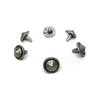Decoration of German Soldiers (Prussia), 35 x 35 mm, 925 Antique Silver plated, 2 ribet pins
The Iron Cross (a black four-pointed cross with white trim, with the arms widening towards the ends, similar to a cross pattée), was designed by the neoclassical architect Karl Friedrich Schinkel and reflects the cross borne by the Teutonic Knights in the 14th century. The ribbon for the 1813, 1870 and 1914 Iron Cross (2nd Class) was black with two thin white bands, the colours of Prussia. The noncombatant version of this award had the same medal, but the black and white colours on the ribbon were reversed. Initially the Iron Cross was worn with the blank side out. This did not change until 1838 when the sprig facing could be presented. Since the Iron Cross was issued over several different periods of German history, it was annotated with the year indicating the era in which it was issued. For example, an Iron Cross from the First World War bears the year "1914", while the same decoration from the Second World War is annotated "1939". The reverse of the 1870, 1914 and 1939 series of Iron Crosses have the year "1813" appearing on the lower arm, symbolising the first year the award was created. The 1813 decoration also has the initials "FW" for King Frederick William III, while the next two have a "W" for the respective kaisers, Wilhelm I and Wilhelm II. The final version shows a swastika. It was also possible for a holder of the 1914 Iron Cross to be awarded a second or higher grade of the 1939 Iron Cross. In such cases a "1939 Clasp" (Spange) would be worn on the original 1914 Iron Cross. (A similar award was made in 1914 but was quite rare, since there were few in service who held the 1870 Iron Cross.) For the First Class award the Spange appears as an eagle with the date "1939" that was pinned above the Cross. Although two separate awards, in some cases the holders soldered them together. A cross was the symbol of the Teutonic Knights (a heraldic cross pattée), and the cross design (but not the specific decoration) has been the symbol of Germany's armed forces (now the Bundeswehr) since 1871.













